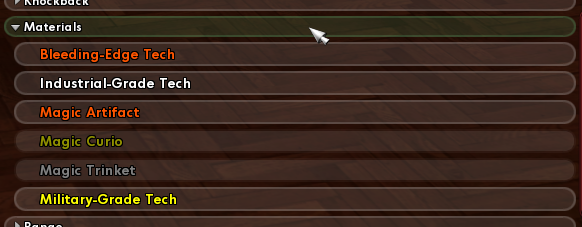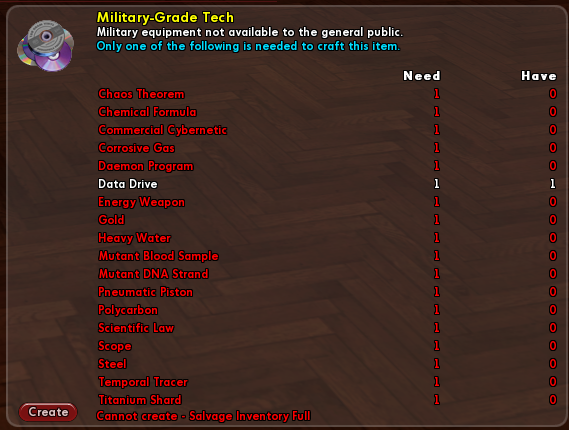Guides Guides Guides Guides
Invention Invention Invention Invention
History of Salvage
In Issue 9 of City of Heroes, the invention system was introduced, allowing players to craft costume pieces, temporary powers, and, primarily, enhancements. Invention recipes could be acquired from random drops or from NPC vendors in some cases. Salvage items, used for crafting recipes, also dropped randomly from defeating enemies. Also added in Issue 9 was the Auction House where players could buy and sell recipes, salvage, and other things.
Since there were 108 different salvage items, and player inventory was limited to 80 individual salvage items, it was common to sell all salvage on the auction house to clear inventory space and buy them back later as needed. As mentioned in the article about enhancements, Invention Origin enhancements were not better than Single Origin enhancements until level 26, so players would begin a tedious process of buying a long shopping list of salvage and recipes from the auction house at this level. Because some recipes were much more sought-after than others, the market became endlessly inflated to the point that one character could not hold the inf (currency) required to buy a set of enhancements.
Our Changes

Thunderspy condensed the 108 salvage items down to just 6 materials to streamline the process. Materials are categorized as Common, Uncommon, and Rare in Tech and Magic themes. The purpose of this is to streamline the crafting system to spend less time writing a shopping list for the auction house and less time using invention tables. Because there are less types of materials, the ones acquired from random drops are woth holding onto instead of selling immediately. We’ve also seeded salvage at an NPC vendor to keep inflation down, so players don’t need to grind to afford anything.

Old salvage may still be in circulation either from the inventory of returning players or mistakes in the code. Any old salvage can be crafted to materials for free at the invention table.

History of Salvage
In Issue 9 of City of Heroes, the invention system was introduced, allowing players to craft costume pieces, temporary powers, and, primarily, enhancements. Invention recipes could be acquired from random drops or from NPC vendors in some cases. Salvage items, used for crafting recipes, also dropped randomly from defeating enemies. Also added in Issue 9 was the Auction House where players could buy and sell recipes, salvage, and other things.
Since there were 108 different salvage items, and player inventory was limited to 80 individual salvage items, it was common to sell all salvage on the auction house to clear inventory space and buy them back later as needed. As mentioned in the article about enhancements, Invention Origin enhancements were not better than Single Origin enhancements until level 26, so players would begin a tedious process of buying a long shopping list of salvage and recipes from the auction house at this level. Because some recipes were much more sought-after than others, the market became endlessly inflated to the point that one character could not hold the inf (currency) required to buy a set of enhancements.
Our Changes

Thunderspy condensed the 108 salvage items down to just 6 materials to streamline the process. Materials are categorized as Common, Uncommon, and Rare in Tech and Magic themes. The purpose of this is to streamline the crafting system to spend less time writing a shopping list for the auction house and less time using invention tables. Because there are less types of materials, the ones acquired from random drops are woth holding onto instead of selling immediately. We’ve also seeded salvage at an NPC vendor to keep inflation down, so players don’t need to grind to afford anything.

Old salvage may still be in circulation either from the inventory of returning players or mistakes in the code. Any old salvage can be crafted to materials for free at the invention table.

History of Salvage
In Issue 9 of City of Heroes, the invention system was introduced, allowing players to craft costume pieces, temporary powers, and, primarily, enhancements. Invention recipes could be acquired from random drops or from NPC vendors in some cases. Salvage items, used for crafting recipes, also dropped randomly from defeating enemies. Also added in Issue 9 was the Auction House where players could buy and sell recipes, salvage, and other things.
Since there were 108 different salvage items, and player inventory was limited to 80 individual salvage items, it was common to sell all salvage on the auction house to clear inventory space and buy them back later as needed. As mentioned in the article about enhancements, Invention Origin enhancements were not better than Single Origin enhancements until level 26, so players would begin a tedious process of buying a long shopping list of salvage and recipes from the auction house at this level. Because some recipes were much more sought-after than others, the market became endlessly inflated to the point that one character could not hold the inf (currency) required to buy a set of enhancements.
Our Changes

Thunderspy condensed the 108 salvage items down to just 6 materials to streamline the process. Materials are categorized as Common, Uncommon, and Rare in Tech and Magic themes. The purpose of this is to streamline the crafting system to spend less time writing a shopping list for the auction house and less time using invention tables. Because there are less types of materials, the ones acquired from random drops are woth holding onto instead of selling immediately. We’ve also seeded salvage at an NPC vendor to keep inflation down, so players don’t need to grind to afford anything.

Old salvage may still be in circulation either from the inventory of returning players or mistakes in the code. Any old salvage can be crafted to materials for free at the invention table.

History of Salvage
In Issue 9 of City of Heroes, the invention system was introduced, allowing players to craft costume pieces, temporary powers, and, primarily, enhancements. Invention recipes could be acquired from random drops or from NPC vendors in some cases. Salvage items, used for crafting recipes, also dropped randomly from defeating enemies. Also added in Issue 9 was the Auction House where players could buy and sell recipes, salvage, and other things.
Since there were 108 different salvage items, and player inventory was limited to 80 individual salvage items, it was common to sell all salvage on the auction house to clear inventory space and buy them back later as needed. As mentioned in the article about enhancements, Invention Origin enhancements were not better than Single Origin enhancements until level 26, so players would begin a tedious process of buying a long shopping list of salvage and recipes from the auction house at this level. Because some recipes were much more sought-after than others, the market became endlessly inflated to the point that one character could not hold the inf (currency) required to buy a set of enhancements.
Our Changes

Thunderspy condensed the 108 salvage items down to just 6 materials to streamline the process. Materials are categorized as Common, Uncommon, and Rare in Tech and Magic themes. The purpose of this is to streamline the crafting system to spend less time writing a shopping list for the auction house and less time using invention tables. Because there are less types of materials, the ones acquired from random drops are woth holding onto instead of selling immediately. We’ve also seeded salvage at an NPC vendor to keep inflation down, so players don’t need to grind to afford anything.

Old salvage may still be in circulation either from the inventory of returning players or mistakes in the code. Any old salvage can be crafted to materials for free at the invention table.

